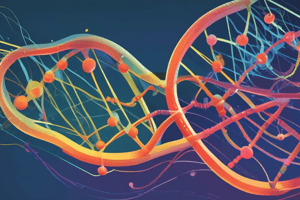Podcast
Questions and Answers
What are the main components of a nucleotide?
What are the main components of a nucleotide?
- Amino acid, deoxyribose, phosphate group
- Nitrogenous base, pentose sugar, one or more phosphate group (correct)
- Nitrogenous base, glucose, two phosphate groups
- Nitrogenous base, ribose, phosphate group
Which nitrogenous bases are classified as purines?
Which nitrogenous bases are classified as purines?
- Thymine and Uracil
- Cytosine and Thymine
- Adenine and Guanine (correct)
- Adenine and Cytosine
Which sugar is found in ribonucleotides?
Which sugar is found in ribonucleotides?
- Ribose (correct)
- Deoxyribose
- Glucose
- Sucrose
What is a primary function of nucleotides?
What is a primary function of nucleotides?
What is the role of cAMP in biological systems?
What is the role of cAMP in biological systems?
What does the process of adding a phosphate group to a nucleoside produce?
What does the process of adding a phosphate group to a nucleoside produce?
Which substance is used as a purine analogue for the treatment of gout?
Which substance is used as a purine analogue for the treatment of gout?
Which of the following functions does ATP perform?
Which of the following functions does ATP perform?
Flashcards are hidden until you start studying
Study Notes
Nucleic Acid Chemistry
- Nucleic acids are polymers made up of repeating subunits called nucleotides.
- Nucleotides consist of three components: a nitrogenous base, a pentose sugar, and one or more phosphate groups.
- Nitrogenous bases are categorized into two groups: purines (adenine and guanine) and pyrimidines (cytosine, thymine, and uracil).
- DNA contains deoxyribose sugar and RNA contains Ribose sugar.
- A nucleoside is formed by the addition of a base to the C1 position of the pentose sugar via a glycosidic bond.
- Phosphate groups are added to the C5 position of the pentose sugar via an ester bond.
- Nucleotides have diverse roles such as:
- Building blocks of DNA and RNA.
- Energy sources: ATP and GTP.
- Mediators of hormone action: cAMP and cGMP act as second messengers.
- Co-enzymes: NAD and FAD.
- Activation of chemical compounds: UDP-glucose for glycogen synthesis, CDP choline and CDP-ethanolamine for phospholipid synthesis.
- Donors of chemical groups: PAPS (sulfate donor) for sulfolipid synthesis and SAM (methyl donor) for transmethylation reactions.
- Synthetic analogues of nucleotides are used therapeutically in medicine.
- Allopurinol is a purine analogue that inhibits xanthine oxidase enzyme, decreasing uric acid synthesis and helping treat gout.
- 5-fluorouracil and 6-mercaptopurine are pyrimidine and purine analogues that inhibit DNA and RNA synthesis, respectively. These are used as anti-tumor agents in chemotherapy, targeting rapidly growing cancer cells.
Studying That Suits You
Use AI to generate personalized quizzes and flashcards to suit your learning preferences.




